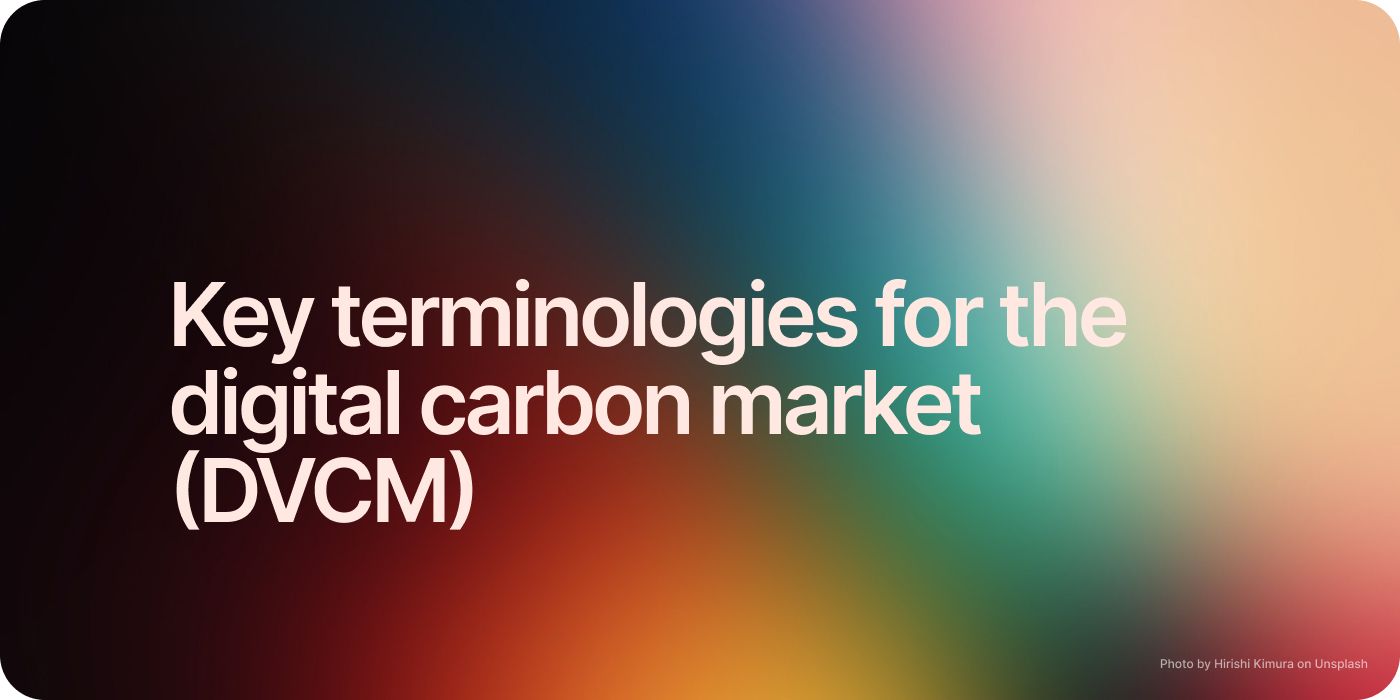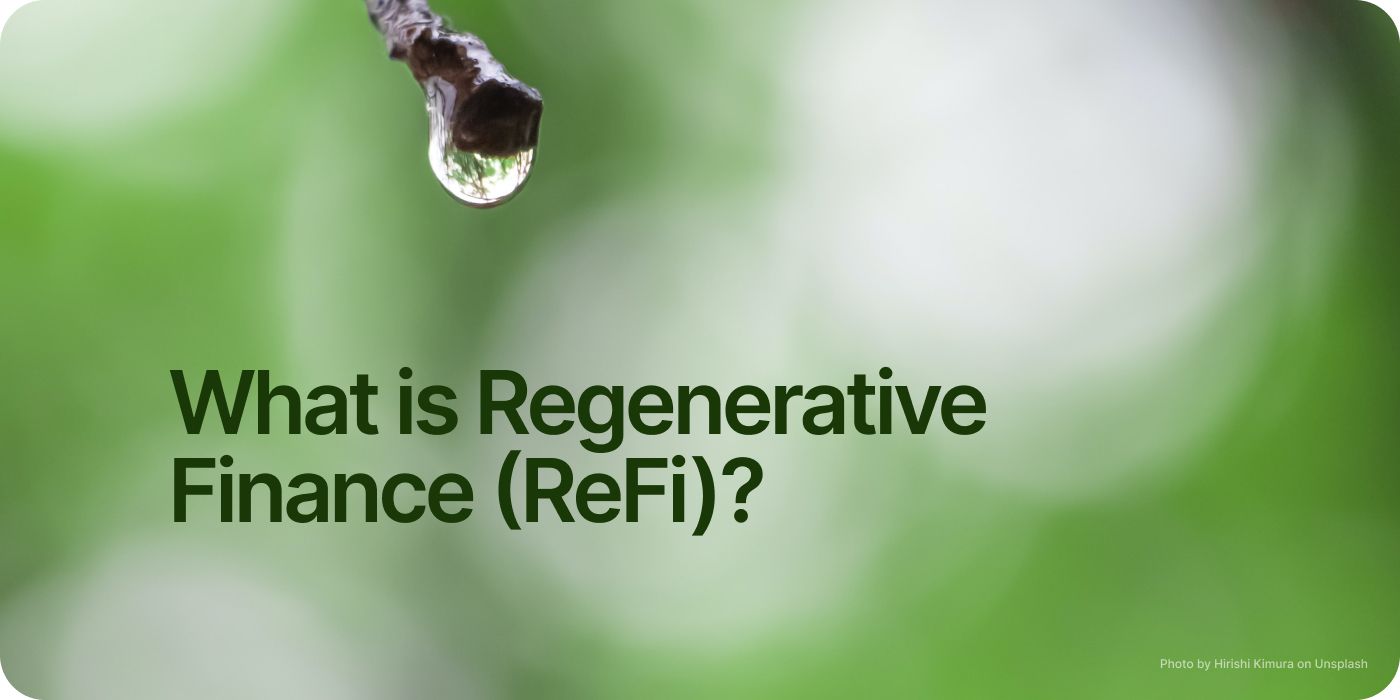What is climate tech, and why should you get involved?
The climate tech industry is a rapidly growing field with unique opportunities to make a meaningful impact. We explore what climate tech is, who can work in climate & why blockchains are key to scale impact.

Climate change is an enormous challenge – and we have to combine our efforts to address it as swiftly as possible. We are already experiencing its outcomes across the globe, from rising sea levels to more frequent and severe weather events. Reducing our carbon footprint and transitioning to a low-carbon economy is key to maintaining a livable planet for future generations. And to rapidly de-carbonize our atmosphere, we need innovative solutions and technologies that can help us scale down greenhouse gas emissions and mitigate the effects of climate change.
- Carbon removal or capture and storage
- renewable energy projects
- tools for sustainable farming
- emission measurement, reporting & verification tooling
What skills are needed in climate tech?
The climate tech industry is a rapidly growing field that offers unique opportunities for talented and passionate people around the globe to make a meaningful impact. Investment in the sector is projected to reach $1.3 trillion by 2025, as more countries and companies commit to reducing their carbon footprint and transitioning to a low-carbon economy.
There is a wide range of career opportunities to choose from in climate tech, from engineering and product design jobs, to policy work, marketing, and education.
A few climate tech businesses we love 👇
- Digital Gaia: Digital Gaia is a climate tech company with a mission to drive the growth of sustainable agri-tech through open science. They leverage decentralized technologies to help entrepreneurs and scientists measure and validate the impact of their projects. Find them on Twitter.
- Puro: Puro.earth is a carbon crediting platform that specializes in engineered carbon removal. They focus on verified net-negative technologies that have the ability to remove carbon from the atmosphere on an industrial scale, and store it for at least 100 years. The company consolidates various methods of CO2 removal and transforms them into CO2 Removal Certificates (CORCs). Find them on Twitter.
- Charm: Charm converts leftover plant material from farms into a valuable substance called bio-oil. This bio-oil is then safely stored deep underground, preventing carbon from being released into the air. For example, when corn stalks are left to decompose after harvest, they emit carbon into the atmosphere, but Charm's process prevents this from happening. Find them on Twitter.
- Watershed: Watershed is a climate platform that supports businesses in measuring and reporting their carbon footprint, and helps them take action to reduce carbon emissions. Find them on Twitter.
- Redwood Materials: Redwood Materials is a company that specializes in the recycling of lithium-ion batteries, and the creation of battery materials for use in electric mobility and energy storage systems. Their mission is to transform the battery supply chain by providing abundant sources of anode and cathode materials that are produced on a large scale. Find them on Twitter.
- Heirloom: Heirloom is a startup that specializes in Direct Air Capture (DAC) technology that speeds up the natural process of removing CO2 from the atmosphere in just a matter of days. They offer carbon removal credits that can be purchased by individuals and companies alike. Find them on Twitter.
- Pachama: Pachama is a climate-tech company that employs innovative remote sensing and AI technologies to safeguard the world's natural carbon sinks. They can estimate the amount of carbon stored in forests, both currently and in the future. Additionally, they are able to track deforestation and monitor forests to ensure they are not destroyed. Find them on Twitter.
Please note that most of these organizations currently do not use blockchain technology.
Working in climate tech can be highly rewarding, as it combines a solid career choice with ways to actively contribute to a better future for our planet. In addition, today's climate tech founders and builders are developing a skillset and deep knowledge that will likely be in high demand for years to come.
Blockchains: A new tool to solve old problems
Blockchain technology has developed over the last years, and it could potentially be key for climate action. While blockchains themselves are not a panacea for climate action, they are a highly effective new tool that we can leverage to optimize the climate tech industry. With open blockchains, we have a host of new and innovative solutions at our fingertips to address various challenges in the industry. Let’s explore avenues through which blockchain technology is helping address blockers that have previously slowed down innovation and scaling of climate action, such as coordination failures, opaque markets and data silos.

Global coordination
One of the key benefits of blockchains is that they enable collaboration beyond what was previously possible. Distributed ledgers provide a decentralized and transparent platform for recording transactions, and allow multiple parties to access the same information at the same time. Everyone can rely on the fact that data cannot be changed by any other singular party. This “trustless” nature of blockchains makes it easier for large groups of stakeholders to collaborate towards a common goal, especially in situations where trust is an issue.
Additionally, the use of smart contracts on blockchains can automate certain aspects of the collaboration, such as the distribution of rewards for desired behavior (e.g. positive climate impact) or the execution of simple tasks. As a result, blockchains have the potential to revolutionize and streamline the way that people or organizations across nations coordinate in the digital age. This large-scale coordination is key for addressing climate change – a complex, multi-dimensional challenge like this inherently requires global coordination between many stakeholders, from governments and corporations to local communities.

Increased transparency
Everything that happens on a blockchain – updating data, sending funds from one account to another, or retiring carbon credits – leaves a data trail that cannot be altered. This data can be accessed by anyone, at any time, and from anywhere in the world. Such a public and transparent record of all transactions can help reduce the risk of fraud and corruption often associated with certain types of climate finance. And money flows from the global north to the global south are transparently verifiable by everyone.

New users and opportunities
Blockchain technology also unlocks completely new ways to accelerate climate action, from digital impact dashboards and decentralized carbon credit marketplaces, to the financialization of environmental assets.
The fractionalization of carbon credits for example, allows more people to participate in climate finance, as the price of market entry becomes lower. Existing capital in the cryptocurrency space can flow into climate finance via blockchain-powered impact products without friction.
The novel ReFi movement has been born out of Web3 design principles and aims to create a new financial system that shifts from extracting resources to regenerating the planet and communities.

Interoperability
“Success” for climate tech businesses is not only about succeeding at the level of individual organizations; it’s about moving the needle and making combined progress towards a global goal. Ultimately, we need to develop effective decarbonization technologies and mobilize billions of dollars in climate capital, and we need to do it very fast – an almost impossible task for any single organization. An entire, inherently connected ecosystem of impact products and tools is needed.
Interoperability is key to coordination at scale. We need to heavily focus on building technology that’s interoperable, so that each new product or service benefits the entire ecosystem.
Michael Mezzatesta, Climate Collective
On open blockchains, every smart contract-based application can build on top of what’s already there, which expands the utility of all available products and services and unlocks unbridled innovation. In addition, many blockchains have begun to build “bridges” that allow them to communicate with other blockchains. This new bridging infrastructure critically contributes to a highly interoperable technical ecosystem. Interoperability between protocols allows for faster data sharing, and users can freely move their assets from one blockchain to another.

The value of communication
Looking beyond technology, we also view it as key to stay in close contact and have open conversations with diverse stakeholders across the climate impact space. This is why Toucan is participating in numerous working groups, for example the Gold Standard for Carbon Tokenization working group, and the WEF blockchain for climate action working group. We are also collaborating closely with other organizations in the climate impact space – i.e. Climate Collective – to educate the public on blockchain-powered climate action.
Example: The VCM (Voluntary Carbon Market) for climate action
The VCM (Voluntary Carbon Market) as a tool to finance climate action can only be improved and scaled through a collaborative effort. We need organizations to
- focus on making VCM trading infrastructure more transparent and efficient
- improve dMRV tooling
- execute carbon credit integrity ratings
- develop easy-to-use climate impact dashboards
- educate the public on how to participate in climate finance
- communicate with conventional carbon market stakeholders to identify how to safely integrate new technologies into an existing infrastructure
If every single organization tackling one of these areas leverages open blockchains to store information, all other ecosystem participants can freely utilize this shared data to improve their own offerings, thus making the entire climate impact space better.
Everybody can work in climate tech
It’s never been easier for individuals to break into the field of (blockchain-powered) climate tech, regardless of their educational or professional background. The increasing availability of online resources and educational programs has made it possible for anyone to gain the necessary skills and knowledge to excel in this rapidly expanding industry.

Terra.do is a prime example of a platform that provides accessible courses and training programs, covering a diverse range of climate tech topics, such as renewable energy, sustainable agriculture, and carbon offsetting, among others.
And My Climate Journey collective brings together people that are interested in or working on a climate tech product. They provide educational materials as well as access to an investment fund for climate founders.
Building your climate tech product on Toucan's infrastructure
Toucan is building technology to unlock climate action at scale. Our digital infrastructure allows for the tokenization and pooling of carbon credits. You can integrate these ERC-20 tokenized carbon credits in your digital product for automated climate action, use them as green in-game assets, or design applications that help more people participate in climate finance.
Developing and linking climate tech solutions together is key in our efforts to combat the negative effect of climate change, and to achieve a sustainable future. Blockchain technology provides innovative tooling that we can leverage to build transparent, efficient, and globally interconnected applications for climate action.
We need as many bright minds as possible in the space, including you! We encourage you to start learning, questioning, and engaging with the many climate tech projects you'll come across.


